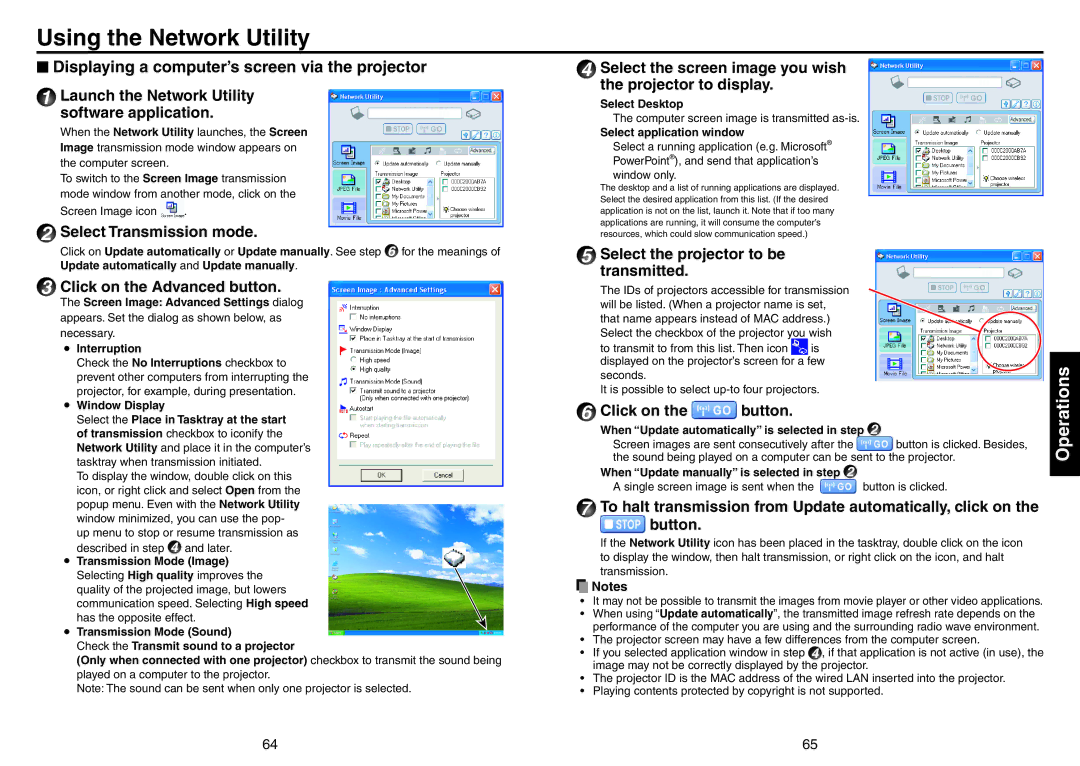
Using the Network Utility
N Displaying a computer’s screen via the projector
1Launch the Network Utility software application.
When the Network Utility launches, the Screen Image transmission mode window appears on the computer screen.
To switch to the Screen Image transmission mode window from another mode, click on the
Screen Image icon ![]() .
.
2Select Transmission mode.
Click on Update automatically or Update manually. See step 6 for the meanings of Update automatically and Update manually.
3Click on the Advanced button.
The Screen Image: Advanced Settings dialog appears. Set the dialog as shown below, as necessary.
•Interruption
Check the No Interruptions checkbox to prevent other computers from interrupting the projector, for example, during presentation.
•Window Display
Select the Place in Tasktray at the start of transmission checkbox to iconify the Network Utility and place it in the computer’s tasktray when transmission initiated.
To display the window, double click on this icon, or right click and select Open from the popup menu. Even with the Network Utility window minimized, you can use the pop- up menu to stop or resume transmission as described in step 4 and later.
•Transmission Mode (Image) Selecting High quality improves the quality of the projected image, but lowers communication speed. Selecting High speed has the opposite effect.
•Transmission Mode (Sound)
Check the Transmit sound to a projector
(Only when connected with one projector) checkbox to transmit the sound being played on a computer to the projector.
Note: The sound can be sent when only one projector is selected.
4Select the screen image you wish the projector to display.
Select Desktop
The computer screen image is transmitted
Select application window
Select a running application (e.g. Microsoft® PowerPoint®), and send that application’s window only.
The desktop and a list of running applications are displayed. Select the desired application from this list. (If the desired application is not on the list, launch it. Note that if too many applications are running, it will consume the computer’s resources, which could slow communication speed.)
5Select the projector to be transmitted.
The IDs of projectors accessible for transmission will be listed. (When a projector name is set, that name appears instead of MAC address.) Select the checkbox of the projector you wish
to transmit to from this list. Then icon ![]() is displayed on the projector’s screen for a few seconds.
is displayed on the projector’s screen for a few seconds.
It is possible to select
6Click on the  button.
button.
When “Update automatically” is selected in step 2
Screen images are sent consecutively after the ![]() button is clicked. Besides, the sound being played on a computer can be sent to the projector.
button is clicked. Besides, the sound being played on a computer can be sent to the projector.
When “Update manually” is selected in step 2
A single screen image is sent when the ![]() button is clicked.
button is clicked.
7To halt transmission from Update automatically, click on the
![]() button.
button.
If the Network Utility icon has been placed in the tasktray, double click on the icon to display the window, then halt transmission, or right click on the icon, and halt transmission.
![]() Notes
Notes
•It may not be possible to transmit the images from movie player or other video applications.
•When using “Update automatically”, the transmitted image refresh rate depends on the performance of the computer you are using and the surrounding radio wave environment.
•The projector screen may have a few differences from the computer screen.
•If you selected application window in step 4 , if that application is not active (in use), the image may not be correctly displayed by the projector.
•The projector ID is the MAC address of the wired LAN inserted into the projector.
•Playing contents protected by copyright is not supported.
Operations
64 | 65 |
